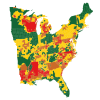bigboreblr
5 year old buck +
I have a lease in the central adirondacks hardiness zone 3A. In december when the snow is over a foot tall, my deer hit it for the nearby lake about 6 miles away. There's a hemlock swampy area around the lake, and the deer can all be seen in the houses around the lake. Come early april, the trail cameras start having deer on them.
All the red dogwood got me thinking of why I started to improve things over there. I am hoping to attract a few extra familes of doe on my lease, so we see more bucks. Trophy selection isnt the best due to nutrition and hunter density in these areas. MY plan has seen to be working so far.
Planting red dogwood and willow on the swamp edges and water spots. Planting clover and grain that come awake early. I even lime and fertilize the soft mast like adlers and more other small shrub trees in spots. Got a few crabapples and plum trees here n there, no big return yet after 2 years. Growing a little spot or two of lupine and see how that goes....
The lease is from a land management company that logs for paper pulp and for birch veneer for plywood. Cherry trees are protected. So, far as hinge cutting and cutting mature trees is a no no. But, we're allowed to maintain trails. Very pristine, wide, legume laiden ones....... Some years logging trucks trash my spots.. So, I got to clean up ruts. In the sunnier spots, i get a nice path. I also do trail intersections and a couple treestand shooting lanes for cameras.
I can magine herding deer in other areas for other reasons, elevation change summer drought and other reasons. Mine are the harsh winter.
Every 3 or 4 years, a nicer buck can be seen on camera sticking around during a mild winter.
All the red dogwood got me thinking of why I started to improve things over there. I am hoping to attract a few extra familes of doe on my lease, so we see more bucks. Trophy selection isnt the best due to nutrition and hunter density in these areas. MY plan has seen to be working so far.
Planting red dogwood and willow on the swamp edges and water spots. Planting clover and grain that come awake early. I even lime and fertilize the soft mast like adlers and more other small shrub trees in spots. Got a few crabapples and plum trees here n there, no big return yet after 2 years. Growing a little spot or two of lupine and see how that goes....
The lease is from a land management company that logs for paper pulp and for birch veneer for plywood. Cherry trees are protected. So, far as hinge cutting and cutting mature trees is a no no. But, we're allowed to maintain trails. Very pristine, wide, legume laiden ones....... Some years logging trucks trash my spots.. So, I got to clean up ruts. In the sunnier spots, i get a nice path. I also do trail intersections and a couple treestand shooting lanes for cameras.
I can magine herding deer in other areas for other reasons, elevation change summer drought and other reasons. Mine are the harsh winter.
Every 3 or 4 years, a nicer buck can be seen on camera sticking around during a mild winter.


